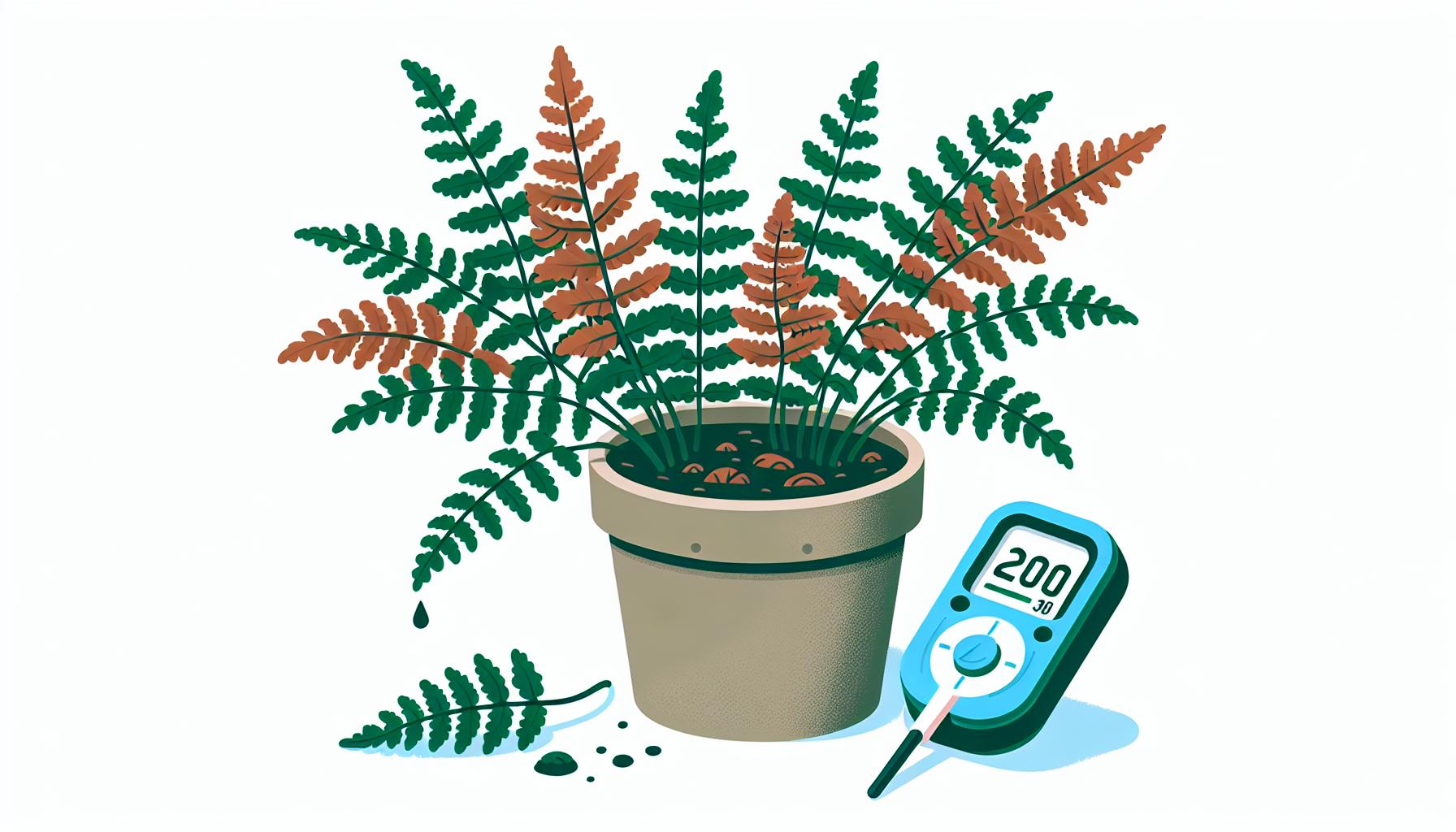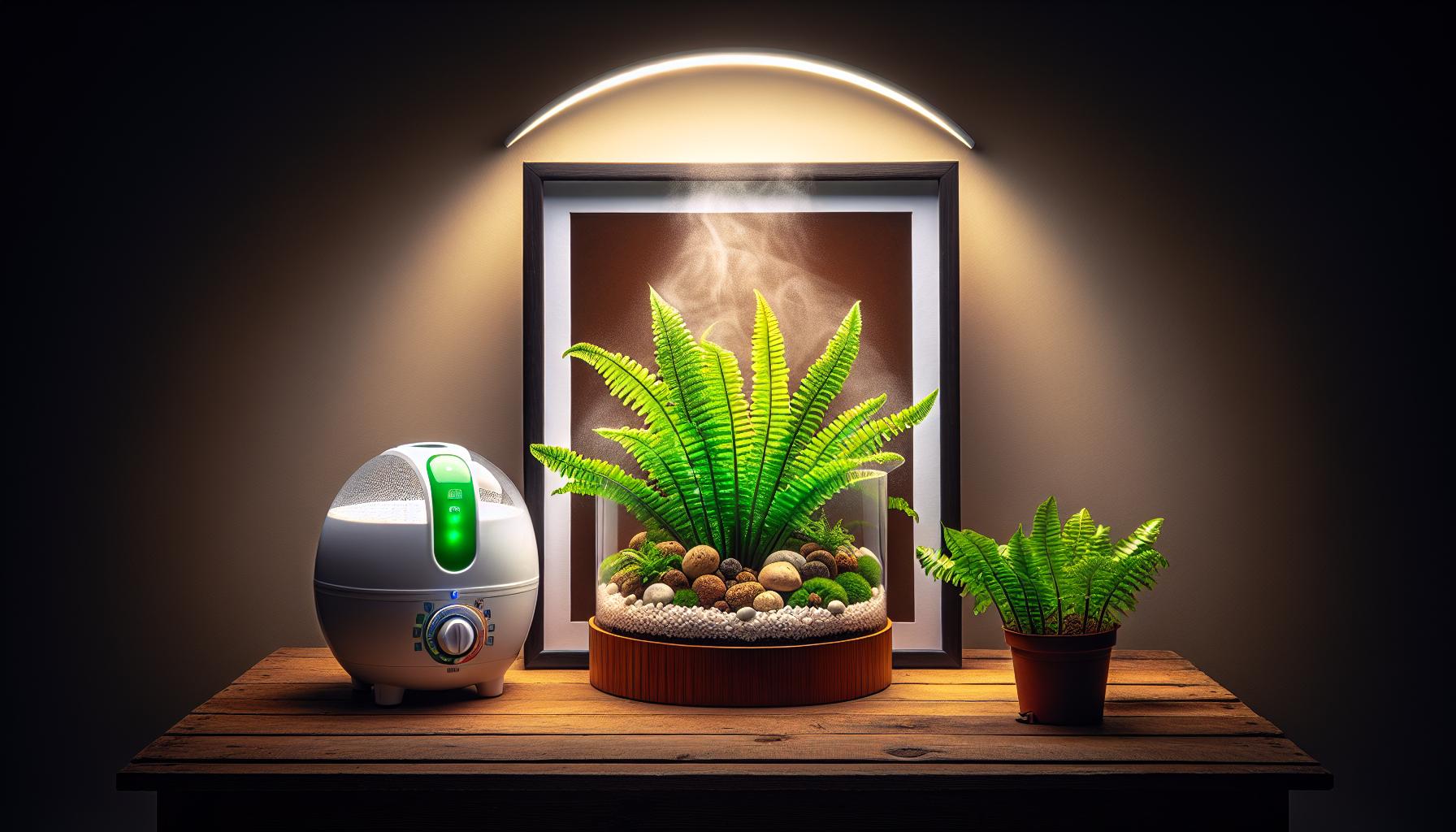
Noticing your fern’s lush green leaves turning brown can be worrisome. You’re likely wondering what’s gone wrong with your beloved plant. Brown fronds could be a cry for help, signalling issues ranging from watering mishaps to environmental stressors.
Understanding why your fern is browning is crucial to nursing it back to health. It’s not just about aesthetics; it’s about ensuring the longevity and vitality of your plant. Let’s delve into the common causes and get your fern thriving again.
Common Causes of Fern Browning
When you notice your fern’s leaves turning brown, it’s often a tell-tale sign that something’s amiss. Pinpointing the exact cause can be tricky, but knowing the most common culprits might save your plant.
Watering Issues are at the top of the list. Ferns require consistent moisture to thrive, but there’s a delicate balance to strike. Overwatering can lead to root rot, characterized by a soft, black root system, while underwatering can cause the leaves to crisp up and brown.
- Overwatering: Leaves become yellow and wilt, soil feels soggy
- Underwatering: Leaves dry out and become brittle, soil separates from pot edges
Lighting Conditions play a crucial role in fern health. These plants love indirect light but can quickly suffer from too much direct sunlight. The delicate leaves start to brown if exposed to harsh rays for extended periods.
- Ideal Light: Bright, indirect sunlight
- Harmful Light: Direct, scorching midday sun
Another factor that might not be as obvious is Humidity Levels. Ferns are known for their love of damp air, and when the humidity drops too low, their fronds can brown and wither. It’s essential to monitor the moisture in the air, especially during dry winter months or in arid climates.
- Preferred Humidity: Above 50%
- Signs of Low Humidity: Brown fronds, leaf drop
Pest Infestations can also cause browning. Tiny insects like spider mites or scale might be feeding on your plant’s sap, stressing it. They leave tell-tale signs like webbing and sticky residue.
Lastly, consider Nutrient Imbalances. Both a deficiency and an excess of certain nutrients can lead to discoloration. Ferns don’t need much fertiliser, so it’s easy to overdo it.
- Key Nutrients: Nitrogen, Potassium, Magnesium
- Overfertilization: Salt build-up in soil, leaf burn
- Underfertilization: Poor growth, pale fronds
To keep your fern lush and vibrant, review these aspects regularly and adjust your care routine as necessary. A healthy fern should show signs of recovery once the primary issue is addressed. Remember, your plant’s response to changes in care will take some time, so be patient and observe its progress.
1. Lack of Proper Watering

Proper watering is vital for the health of your ferns. Too little water leads to a plant’s inability to absorb necessary nutrients, whereas too much water can cause root rot, both resulting in browning leaves.
When you underwater your fern, the once lush green fronds begin to turn brown and dry as the plant struggles to maintain its physiological processes. The cells start to collapse, and the leaf tissue dies off due to a lack of hydration, impeding the plant’s overall growth.
Overwatering, conversely, is just as harmful. It leads to soggy soil, depriving roots of oxygen and making them vulnerable to fungal infections. Signs of overwatering include wilted leaves that appear brown and soft to the touch.
To strike the right balance:
- Feel the soil: Ensure the top inch is dry before watering again.
- Observe the leaves: Wilting or drying indicates when it’s time to water.
- Use filtered or distilled water to avoid salt build-up, which can also contribute to browning.
Regular monitoring of your fern’s soil dampness is a good habit to adopt. Adjust your watering schedule according to seasonal changes, as plants typically require more water during the warmer months and less during cooler periods. Keep an eye out for the unique requirements of your particular fern species as well, since some may have slightly different watering needs.
2. Excessive Sunlight Exposure

When tending to your ferns, it’s crucial to understand their affinity for moderate lighting conditions. Many ferns originate from forest floors, where sunlight is filtered through a canopy of leaves, providing diffused light. Direct sunlight can be particularly detrimental to ferns, as it can scorch their delicate fronds and lead to a condition known as photobleaching. When your ferns are exposed to excessive sunlight, photosynthetic pigments get destroyed which results in the browning of leaves.
To mitigate this, Position Ferns in areas where they will receive indirect or filtered light. Bright, indirect light is the sweet spot for most fern species. For instance, an east-facing window where the sun’s rays are less intense is ideal. If you’ve noticed the fronds of your Boston fern turning a crispy brown, this is a tell-tale sign of too much direct sunlight.
Applying a Sheer Curtain can dramatically reduce light intensity while still allowing your fern to thrive in a well-lit environment. This simple adjustment mimics the natural habitat of the fern, preventing those brown spots from forming on the leaves. Remember, the goal is to replicate the dappled sunlight of a forest, not the harsh, unmitigated rays of a sun-drenched field.
Monitor Light Exposure throughout the day. Sunlight patterns change with the seasons and can impact different areas of your home differently. Be vigilant and reassess the placement of your ferns regularly to ensure they continue to receive optimal light conditions without being subjected to the intense midday sun.
3. Low Humidity Levels

Ferns have a strong preference for moist environments, which means low humidity levels can be quite detrimental to their health. These delicate plants are native to forests and swamps where the air is teeming with moisture. When the air in your home is too dry, the leaves lose water faster than the roots can absorb it, leading to dehydration and subsequent browning.
Improving the humidity around your ferns can prevent further browning and encourage lush growth. Here’s how you can raise the humidity:
- Mist your ferns regularly with lukewarm water to simulate a moist environment.
- Use a humidifier near your plant to maintain a stable level of atmospheric moisture.
- Group plants together to create a microclimate with higher humidity, as plants naturally release water into the air through a process known as transpiration.
- Place a water tray filled with pebbles beneath the plant pot. As the water evaporates, it will increase the humidity around the fern.
Monitoring humidity levels is crucial for fern care. Hygrometers, which measure the amount of moisture in the air, can help you keep track of the humidity in the room. For optimal fern health, aim to maintain the humidity level between 40% to 50%.
Remember, providing your ferns with adequate humidity is just as important as protecting them from excessive sunlight. Regularly check your plants for signs of stress and adjust the environment accordingly to maintain their vibrant green colour and prevent the leaves from turning brown.
4. Poor Air Circulation

Poor air circulation is a less obvious but equally significant culprit when it comes to your fern turning brown. Like most plants, ferns require a consistent flow of air to thrive. Stagnant air not only inhibits growth but can also foster fungal diseases which often manifest as browning on the fronds. Here’s what you need to know to combat poor air circulation:
- Ensure Adequate Space: Airing out your plants is key. Give your ferns room to breathe by spacing them out. This way, air can circulate freely around each plant.
- Strategic Plant Placement: Avoid placing your ferns in corner areas where air tends to get trapped. Instead, position them in locations where indoor air currents naturally occur, such as near an open window or door.
- Use of Fans: If natural air flow is not ideal, consider using a small fan on a low setting to create artificial circulation. This could be especially helpful in areas of your home that are more prone to stale air.
Maintaining proper air flow helps prevent the build-up of moisture on the leaves which can lead to browning. It’s also beneficial to occasionally gently shake your ferns to simulate a fresh breeze, stimulating movement and further enhancing circulation. Remember to balance this with maintaining appropriate humidity levels to avoid drying out your ferns. By taking these steps, you’ll create an environment that allows your ferns to flourish and retain their vibrant green hue.
5. Nutritional Deficiencies
When you’re tending to ferns, the telltale signs of nutritional deficiencies are hard to miss. If your fern’s fronds are turning brown, it may be due to a significant lack of certain nutrients that are vital for plant health.
Nitrogen, Phosphorus, and Potassium are the cornerstones of any plant’s nutrition, often referred to as the N-P-K ratio. A deficiency in Nitrogen usually leads to yellowing leaves which can progress to browning if not corrected. Low levels of Phosphorus can result in fronds that are dark green or reddish-purple before they brown. Whereas, a Potassium shortage often causes the edges of the fronds to dry out and turn brown.
Additionally, trace elements like Magnesium, which plays a pivotal role in chlorophyll production, and Iron, essential for energy transfer, can also impact fern health. Without enough Magnesium, leaves can begin to yellow between the veins before browning, and an Iron deficiency usually results in yellowing leaves with green veins.
Regular fertilization with a balanced, water-soluble fertilizer can help maintain the proper nutrient levels. Be careful, as over-fertilization can harm your ferns. Symptoms of too much fertilizer include a white build-up on the soil surface or leaf burn, where the tips of the leaves turn brown and crispy.
To avoid this, it’s important to understand your specific fern type’s needs. For example, the Boston fern has different nutritional requirements compared to the Staghorn fern. A soil test kit can help identify what your fern may be lacking and allow you to tailor your care approach accordingly.
In the case of Calcium deficiencies, which are rarer but still impactful, new growth is typically deformed or stunted, leading to browning tips or fronds.
By monitoring the balance of these essential nutrients and adjusting your feeding schedule, you’ll give your ferns what they need to thrive and keep brown fronds at bay. Remember, moderation is key – both deficiency and excess can lead to browning and overall poor plant health.
Nursing Your Fern Back to Health

When you notice your fern’s fronds turning brown, immediate action is essential. The first step is to evaluate watering habits; inconsistencies can stress your fern, causing it to brown. A daily check of the soil’s moisture levels is crucial – it should feel moist but not waterlogged. Adjust your watering schedule to maintain this balance, ensuring optimal hydration for your plant.
Mitigating light exposure is also a key factor in your fern’s recovery. Ferns typically thrive in gentle, indirect sunlight. If your fern’s location exposes it to direct, harsh rays, relocate it to a spot with dappled shade or use a sheer curtain to filter the light. This mimics the natural canopy of a forest, which is the preferred environment for many fern species.
Humidity levels play a vital role in a fern’s health. Brown fronds can be a sign of dry air. To increase humidity, you might want to consider using a humidifier or placing a water-filled pebble tray beneath the plant pot. Misting your fern is another option to provide it with the moisture it craves.
Good air circulation is just as important as humidity. Make sure your fern isn’t in a stagnant corner. A gentle breeze can prevent pest infestations and diseases which often contribute to browning. However, avoid placing your fern in the way of strong winds or air conditioning blasts that could dehydrate it.
Finally, review your fertilization schedule. Your fern may need a boost of nutrients, so a balanced, water-soluble fertilizer is a good choice. It’s important to fertilize only during the growing season and to follow the manufacturer’s guidelines to avoid nutrient burn, which can manifest as browning of the fronds.
Monitoring your fern’s response to these changes will guide further care. If the browning persists, you may need to conduct a soil test to check for specific deficiencies that are not being addressed with your current care routine. Remember, each fern type has unique needs, so tailor your approach accordingly.
Ensuring that your fern recovers fully requires patience and attention to its needs. Keeping an eye on the environmental factors and making necessary adjustments will bring back your fern’s lush green appearance over time.
Conclusion
Tackling the issue of your fern turning brown can be straightforward when you know what to look out for. By addressing watering habits, light exposure, humidity, air circulation, and fertilization, you’ll set your fern on the path to recovery. Remember to be patient as your fern slowly regains its vibrant green fronds. With the right care and a bit of time, you’ll enjoy the lush beauty of your healthy fern once again. Keep a close eye on its progress and don’t hesitate to adjust your care routine as needed for the best results.
Colin Macmillan is a seasoned entrepreneur and the CEO of Riverwood Landscape, a leading landscaping company based in Canada. He has been at the helm of the company since leaving high school, demonstrating his strong leadership skills and business acumen.
Colin’s expertise lies in various aspects of landscaping, including lawn care, interlocking, sod installation, and commercial maintenance. His hands-on approach and dedication to the craft have been instrumental in building Riverwood Landscape into a reputable brand.
One of his most notable achievements is the creation of a successful landscape franchise that services multiple locations. This accomplishment underscores his strategic thinking and ability to scale operations effectively.
Colin has also had the privilege of working with Guelph Hospital for landscaping and maintenance, a testament to the trust and reliability that his company has earned over the years.
His professional mission is to offer the best services and experiences for customers, a goal that he tirelessly pursues. Colin’s commitment to excellence and customer satisfaction continues to drive the growth and success of Riverwood Landscape.








